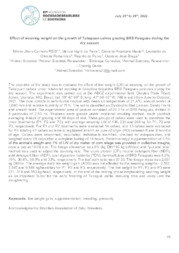Effect of weaning weight on the growth of Tabapuan calves grazing BRS Paiaguás during the dry season.
Effect of weaning weight on the growth of Tabapuan calves grazing BRS Paiaguás during the dry season.
Resumo: The objective of the study was to evaluate the effect of live weight (LW) at weaning on the growth of Tabapuan calves under rotational stocking in Urochloa brizantha BRS Paiaguás pastures during the dry season. The experiment was carried out at the ABCZ experimental farm Orestes Prata Tibery Júnior, Uberaba, MG, Brazil, (lat. 19º 47' 68'' S; long. 47º 58' 50'' W, 788 m asl.) from June to October, 2021. The local climate is semi-humid tropical with mean air temperature of 21,4°C, annual rainfall of 1,680 mm and relative humidity of 71%. The soil is classified as Dystrophic Red Latosol, Sandy Frank and smooth relief. The experimental area of pasture consisted of 20.3 ha of BRS Paiaguás, divided in 8 paddocks of 2.53 ha. Pastures were grazed under rotational stocking method, each paddock averaging 9 days of grazing and 68 days of rest. Three groups of calves were used to constitute the three treatments (P1, P2 and P3), with average weaning LW of 196, 235 and 268 kg for P1, P2 and P3, respectively. For P1 and P2 treatments were evaluated 14 calves, and 13 calves were evaluated for P3, totaling 41 calves as testers, registered at birth as pure of origin (PO) between 6 and 8 months of age. Calves were dewormed, vaccinated, individually identified, checked for ectoparasites, and weighed every 28 days after a complete fasting of 14-hours. Protein-energy supplementation of 0.5% once a day at 10:00 a.m. The forage allowance was 6% (kg DM/100 kg LW/day) and "put and take" method was used to adjust the stocking rate. The crude protein (CP), neutral detergent fiber (NDF), acid detergent fiber (ADF), total digestible nutrients (TDN), hemicellulose of BRS Paiaguás was 8.3%, 70%, 36.8%, 58.9% and 33%, respectively. The leaf:culm ratio was 37:33. The forage mass was 2,631 kg DM/ha. The average daily live weight gain (ADG) was not affected by the weaning weights - 0.552, 0.587 and 0.588 kg/head/day for P1, P2 and P3, respectively. The live weight for P1, P2 and P3 were 271, 318 and 353 kg/head, respectively, at the end of the rearing phase emphasizing weaning weight as an important factor for the early finishing of Tabapuã cattle, reducing time and costs until the slaughtering.
Ano de publicação: 2022
Tipo de publicação: Resumo em anais e proceedings
Unidade: Embrapa Cerrados
Observações
1 - Por padrão são exibidas publicações dos últimos 20 anos. Para encontrar publicações mais antigas, configure o filtro ano de publicação, colocando o ano a partir do qual você deseja encontrar publicações. O filtro está na coluna da esquerda na busca acima.
2 - Para ler algumas publicações da Embrapa (apenas as que estão em formato ePub), é necessário ter, no celular ou computador, um desses softwares gratuitos. Sistemas Android: Google Play Livros; IOS: iBooks; Windows e Linux: software Calibre.
Acesse outras publicações
Acesse a Base de Dados da Pesquisa Agropecuária (BDPA) para consultar o acervo completo das bibliotecas da Embrapa.

